11 best-dressed women with a nationalist soul
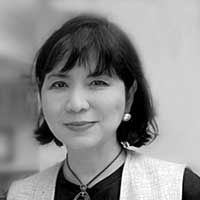
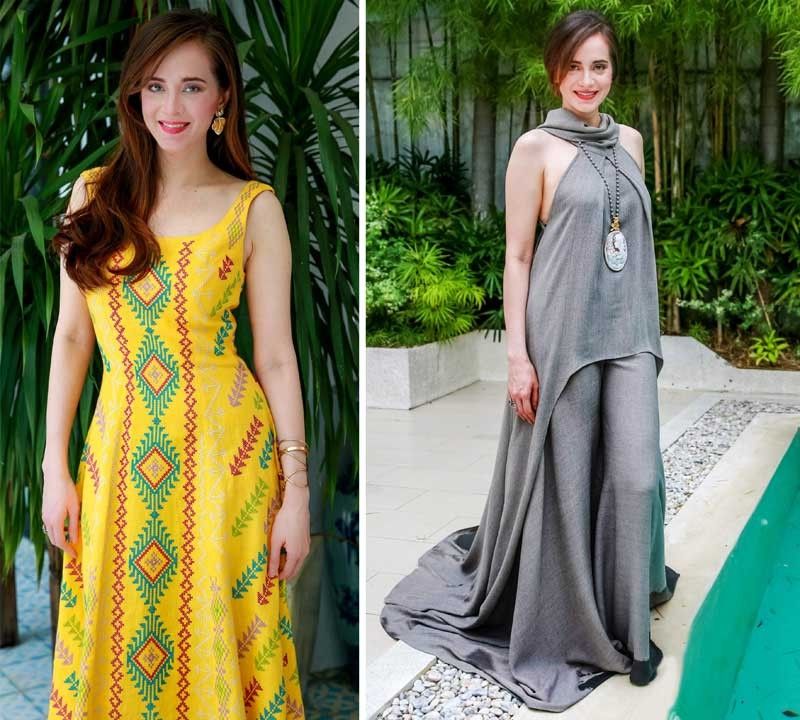
These are very exciting times for Philippine fashion. Never before has there been such a surge of consciousness for clothes and accessories made in the Philippines as now.
For decades, we were awed, first by our Coca-Colonizers who introduced us to all things great and American. Then by European fashion houses which stunned us with beautiful couture. We embraced everything imported and, in the process, we forgot our Filipino identity. We lost our soul.
For a long time, Philippine costumes became just that —costumes to be worn during Independence Day, Philippine-themed weddings, State-of-the Nation addresses. The terno and Maria Clara were “itchy” outfits that were resurrected from the closets for special occasions. Young people wore them only during school programs.
Now, fashion tastemakers as well as the most well-dressed women are #LovingLocal. The hashtag was created by Ben Chan in an effort to make shoppers appreciate local. Could they at least mix their Paul Smith shirts with Bench jeans? Or pair off Hermes bags and Gucci shoes with dresses made by Joey Samson or Inno Sotto? Mix-matching local with foreign worked well, and still does.
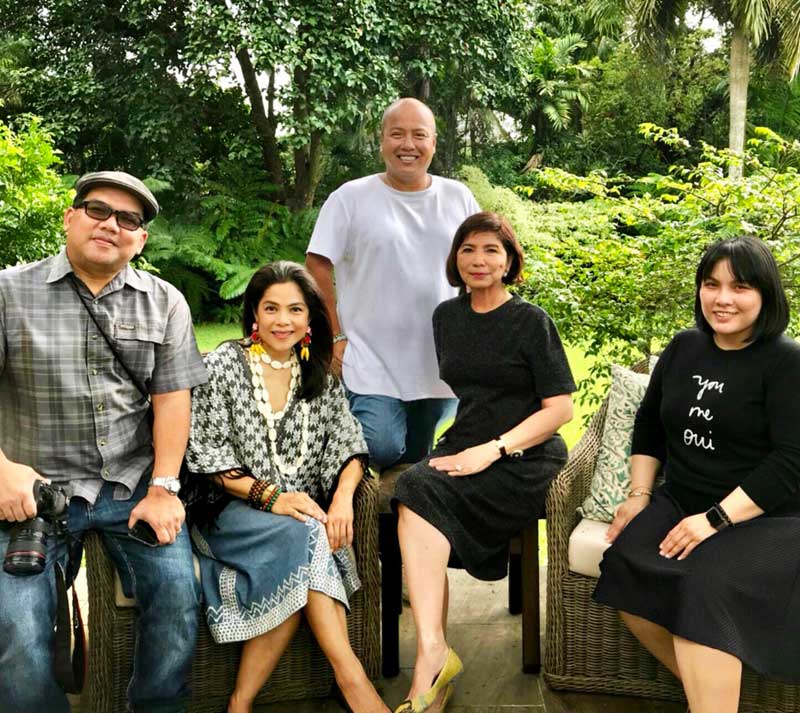
The team taking a break with Kit Zobel in her garden : Geremy Pintolo, Luis Espiritu, Millet Mananquil, Bang Martinez - Produced by Millet Mananquil Styled by Luis Espiritu with associates Bang Martinez Diane lasam Tara Subido Photographed by Geremy Pintolo
The retail giants tried to stir nationalistic passions at a time when it didn’t seem too fashionable yet, especially among the young. Rustan’s created its Filipiniana department with well-curated items carrying the “Our Very Own” tag. SM Shoemart presented good wares made from Ilocos to Iloilo, from the Mountain Province to Mindanao at its Kultura shops.
And now, everybody is loving local. There is now a new breed of young designers and entrepreneurs making local more hip, wearable and modern. Hence the rise of artisanal craft fairs promoting Philippine clothes, fashion accessories and home wares, such as Arte Fino (this year, the organizers made it a three-day affair and yet it was crowded, leaving shoppers begging for a fourth day).
For its part, the CITEM (Center for International Trade ExpositIons and Missions) has been doing its share in making Philippine products more world class. For decades, importers were ordering Philippine wares but attaching their own store or brand labels to them, drowning Filipino designers and artisans in anonymity. Was it Kenneth Cobonpue who first resisted to such oppressive practice , insisting on recognition as a Filipino designer with his own label in foreign markets?
Many Filipino creators now have their own name and fame, thanks to fighters and disruptors like Cobonpue.
In this issue, we chose 11 well-dressed women who are walking advertisements for everything local and beautiful. They literally wear their nationalist hearts on their sleeves. All heart and soul, they #LoveLocal.
Lucy Torres-Gomez
Lucy Torres-Gomez, the epitome of beauty and brains, is Leyte’s 4th district Congresswoman who chairs the Tourism Committee in Congress. Working for livelihood, sports and nutrition projects in her province, Lucy famously launched her 6200 Mission Possible Banca Project, which provided boats for fishermen after Typhoon Yolanda destroyed their tools for livelihood. True to her vision, her Truest project was able to light up homes. She and her husband Richard Gomez, the hardworking Mayor of Ormoc, share a passion for public service even as they are acclaimed as Philippine showbiz royalty.
My interest in Philippine-made clothes and accessories began when I moved to Manila as a new bride. I saw how there was a proliferation of foreign brands — so much more than what was available in the province — and in the same breath there was also so much local talent. I felt that there was so much potential in the local scene, it just needed mentorship… and a break.
The person that opened my eyes to the beauty of local products was Ben Chan. He has always been very nationalistic, has taken pride in local — if raw — talent, and has explored many avenues to highlight and promote the same. He championed the cause long before it became the popular thing to do.
Growing up, I always thought locally-made wares had potential but needed some fine-tuning, so to speak. The talent has always been there, but the design aesthetics have to be carefully edited to make it appealing to the world market.
Now, my favorite local designers are Jul B. Dizon for fine jewelry, Randy Ortiz for exquisite, hand-embroidered dresses, Lupe Saenz for stylish and comfortable shoes made in Marikina, Soumak for furniture and accents with beautiful details, Filip+Inna for gorgeous clothes featuring traditional weaves and stitches, beautiful Tangkulo scarves from Kaayo, and Aranaz for lovely minaudieres.
What I appreciate most about our local wares is that each one has a story, it upholds tradition, it sustains communities, it is a badge of pride.
7. My wish for the local fashion industry/ artisans and weavers is for the tradition to go on and on, as a way of honoring our heritage, and for the same to be more and more appreciated as time goes by.
8. My local must-haves are Tangkulo scarves, embroidered dresses, Aranaz minaudieres, Truest luggage cubes. Especially when I travel abroad I see it as a chance to showcase most things Filipino.
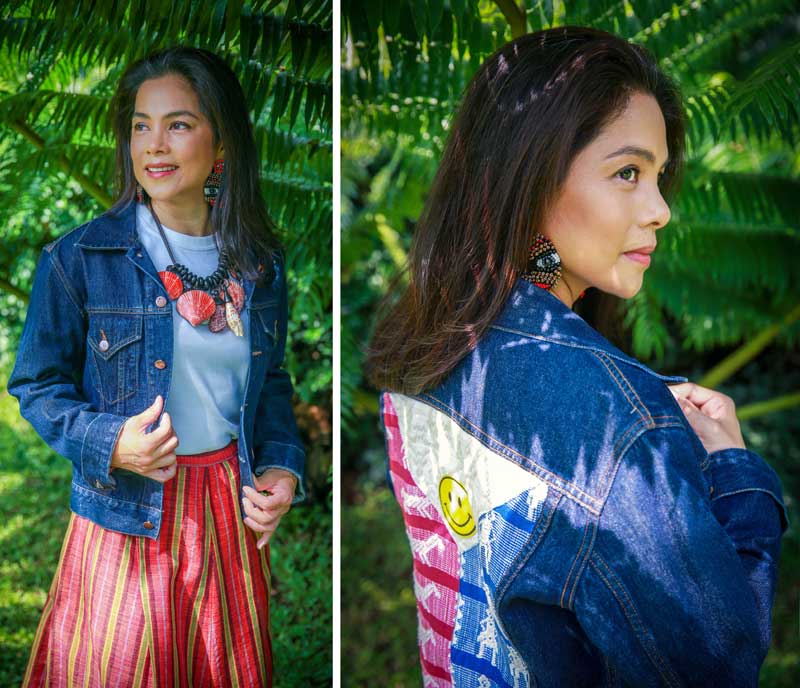
Denim jacket (left and right) by PioPio , red skirt by Balay ni Atong, necklace by Ian Giron; beaded face earrings from Eleanor Beaded Work by Annabelle Omaque of Cebu.
Kit Zobel
Kit Silverio–Zobel is a cultural activist who helps the youth through the Ayala Foundation’s Center of Excellence in Public Elementary Education. She shares the vision of her husband, Ayala Corporation president and COO Fernando Zobel, in giving quality education to underprivileged children.
My interest in Philippine-made clothes and accessories began when Silk Cocoon a while back came out with a lovely line of silk barongs with a modern twist. The cut was more feminine, there were unique details on the sleeves and the colors were bright and vivid. The barong became a fun piece to wear for a lunch or dinner apart from just a cultural event.
My eyes were opened to the beauty of local products with the proliferation of trunk shows as a venue for showcasing artisans and their crafts. This eventually evolved into bigger, much-awaited events such as HABI, MaArte, ArteFino and CITEM.
Growing up, I thought locally made wares were only for pasalubong to bring abroad or to be worn only for cultural events.
Now, my favorite local designers and artisans are PioPio (by Paloma Zobel) for fun, colorful pieces that are playful; Ken Samudio for accessories; Amarie for her updated twist on embroidered barongs and dresses; Filip + Inna for outfits that have gorgeous embroidery from Mindanao; Anthill for unique pieces done in Philippine weaves; Alegre for modern jusi barongs… and the list goes on an on. There is so much talent to be proud of in our country. And we haven’t even covered home décor yet!
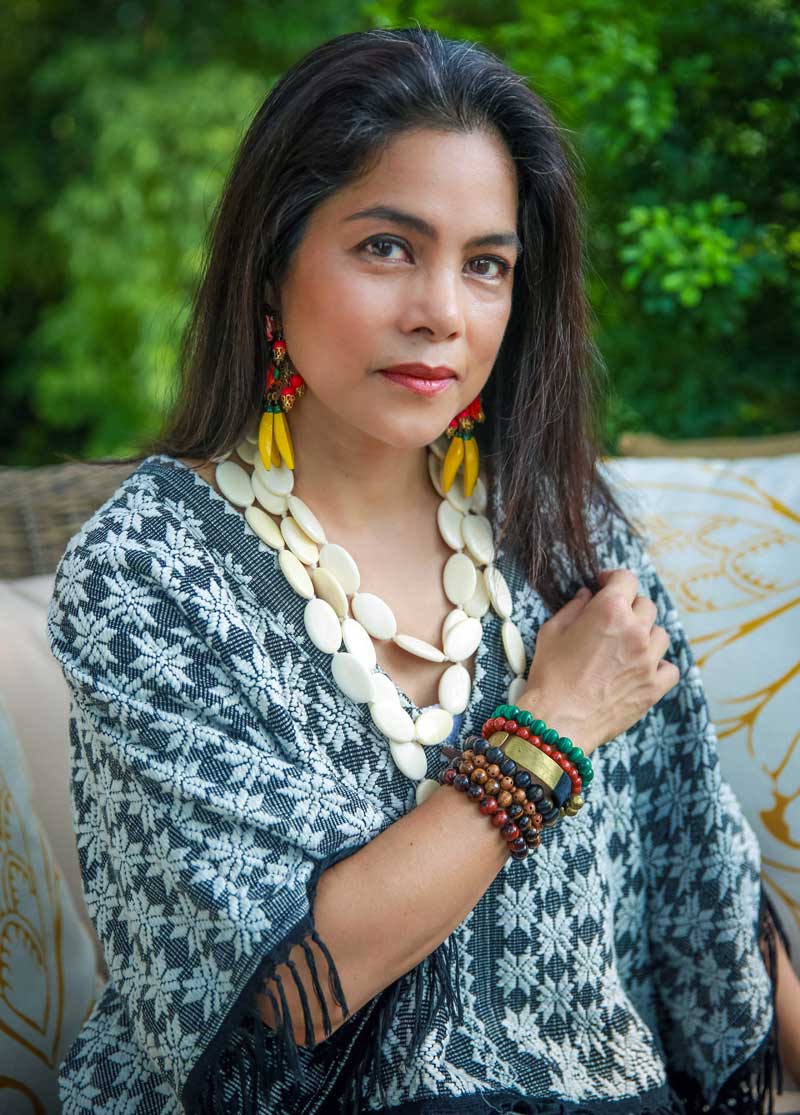
Printed poncho by PioPio , earrings by Sepa, statement necklace by Silnag, bangles by Joyce Makitalo
What I appreciate most about our local wares is that when a local product is handmade, you know the amount of work and love that has gone into it.
When I wear local, I feel unique, special, and proud.
My wish for the local fashion industry is for traditions to continue and be handed down to the next generation and for the artisans and designers to get all the attention and support they deserve locally and globally. It’s already happening; may it continue to grow and multiply.
When I travel I always make it a point to bring a few interesting Filipino pieces with me and they always get noticed, be it a hand-woven scarf, hand-embroidered caftan, or an embellished top. It is so nice to see, whenever friends get together nowadays, most are wearing at least one locally made item.
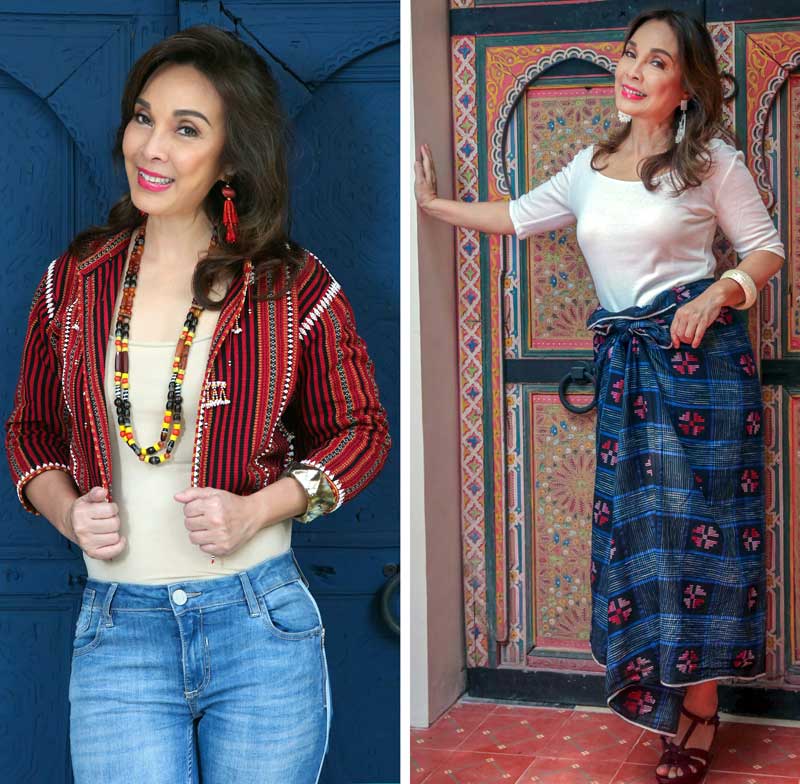
Handwoven jacket (left photo) from the Gaddang community of Mountain Province, earrings from Lily Jewelry, necklace from Kalinga, bracelet from a micro-enterprise in Cebu; handwoven patadyong (right) from BagtasonLoomweavers Association in Bugasong, Antique, earrings from Lily Jewelry
Loren Legarda
Loren Legarda is a three-term Senator who chairs the Senate Committees on Finance, Foreign relations and Climate Change. The multi-awarded journalist is also a reserve officer of the Philippine Air Force with the rank of full colonel. We salute this environmentalist champion who was named one of the Global Leaders of Tomorrow by the World Economic Forum. A tireless cultural worker, Loren was knighted by the French and Italian governments and conferred the Dangal ng Haraya — Patron of Arts and Culture by the National Commission for Culture and the Arts.
My interest in Philippine-made clothes and accessories began when I was a child. My mother, the late Bessie Bautista Legarda, kept a baul of beautiful, locally made textiles in her collection. When I became a journalist, I would often explore the lives and culture of our different ethno-linguistic groups — the Aetas of Zambales, the Yakans of Zamboanga, the people of the Cordilleras, to name a few. As I did stories on them, I would also discover their weaves, embroidery, pottery and various traditional crafts.
My eyes were further opened to the beauty of local products as a young journalist when I had the chance to personally see a handloom weaver at work, I really appreciated not only the effort but also the love and intricacy that they put into every textile that they do. Each craft tells a story and a long history of a heritage well-kept amid the disruptive pace of our modern world.
Growing up, I thought locally made clothing was exquisite. It had soul. As a child I would see them being worn on special occasions or displayed in museums and exhibits so I thought they were beautiful but not for everyday wear.
Now, my favorite local artisans are our indigenous peoples all over the country. I have worn a Bagobo blouse paired with jeans, a T’boli upper garment matched with black slacks and a Maranao landap malong paired with plain long-sleeved shirt. At the opening of the Senate’s session for the 16th Congress, I wore a full Gaddang outfit composed of an aken (skirt), a barawasi (blouse), and a bakwat (belt), which were all woven out of cotton kapat thread and accessorized with the traditional Gaddang intricate beadwork. For the State of the Nation Address (SONA) in 2014, I wore a Mandaya attire composed of a badô (blouse) with embroidered geometric designs of colorful threads and beads, and a dagmay (hand-woven skirt) made of abaca strips dyed using organic colorants from plants and herbs.
Some of my favorite pieces include a 122-year-old hand-woven patadyong made of pure cotton thread and indigo dye from Bugasong town in my home province of Antique; a kinamayan skirt by the Tingguians of Abra; the Bagobo skirt woven by Master Weaver Tia Ines Pandian of the Bagobo Tagawaba community in Davao del Sur; embroidered blouses created by Rowena Caballero-Rafil, daughter of Federico Caballero, a Panay-Bukidnon epic chanter who is a Manlilikha ng Bayan; and tie-dyed skirts from Sammy Buhle of Ifugao Ikat and Lily Luglug of Lab Tie Dye Weavers Association.
I also support our young designers who have started to appreciate the work of our IPs. I have IP-inspired contemporary pieces from Kaayo, Filip+Inna, Marie, Wear Your Culture, Linea Etnika; as well as locally-made accessories from J.E.R. Shellcraft Creation from Cebu, Lily Jewelry, Chill by Nooks, Silnag Horn, and Joyce Makitalo, and Marikina-made shoes by Tish Sevilla.
My wish is for the local fashion creations to be the top choice of Filipinos. During my first term as Senator, I authored Republic Act 9242, the Philippine Tropical Fabrics Law, which promotes the country’s natural fabrics through their use for official uniforms of government employees. I have also spearheaded programs to create awareness about our weaving traditions and cultural heritage through the Hibla ng Lahing Filipino Gallery, the country’s first permanent textile exhibit at the National Museum; and to make local weaves and crafts accessible to more Filipinos through the National Arts and Crafts Fair.
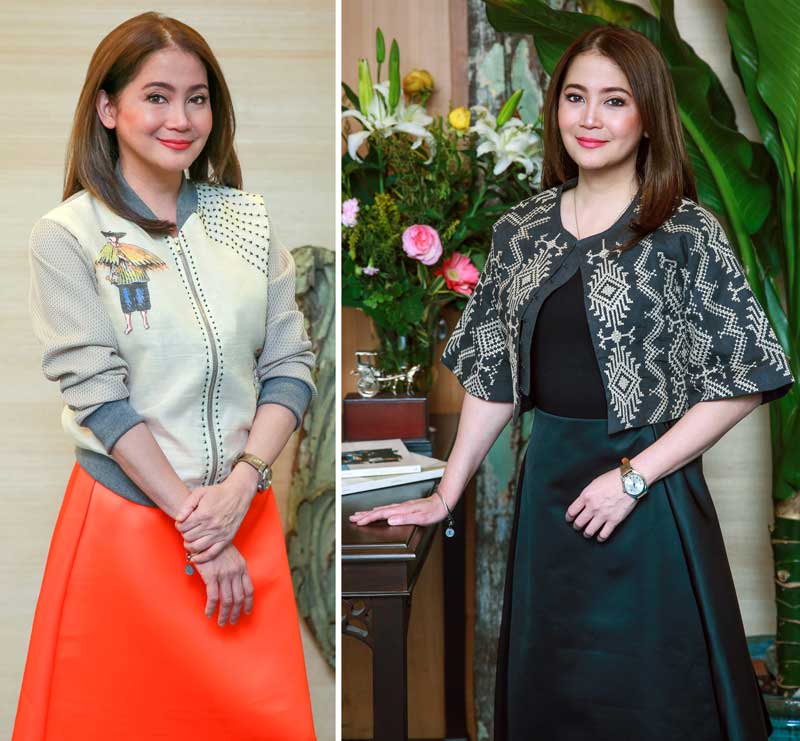
Tipos del Pais piña and mesh bomber jacket and skirt (left photo) by Rhett Eala; hand-embroidered jacket by Filip+Inna (right), black skirt by Rhett Eala
Berna Romulo-Puyat
Berna Romulo-Puyat literally started getting her feet wet with the Boracay redevelopment project after she was appointed Secretary of Tourism. Previous to this, she was walking on dirt soil with farmers as Undersecretary of Agriculture. “I am on the job and on call practically 24 hours a day,” she says. She got her work ethic from her father, former Secretary of Foreign Affairs and Senator Alberto Romulo, who has served the country for decades.
My interest in Philippine-made clothes and accessories began when I saw the barong tops and dresses made by Anne Marie Saguil. It was a modern take on our barong and it was something I could wear anywhere at any occasion. It didn’t look like it was for Linggo ng Wika day.
The person who opened my eyes to the beauty of local products was Anne Marie Saguil of Amarie and Len Cabili of Filip + Inna who were the first to make clothes that were distinctly Filipino with a modern twist.
Also, all the local farmers I met during my stint at the Department of Agriculture made me realize that we had local produce that was at par with the rest of the world.
Growing up, I thought locally made wares were of poor quality and something I would never be caught wearing.
My favorite local designers? I have several. Inno Sotto. He made my wedding gown and has continually made clothes for me throughout the years. Inno’s clothes are timeless and his designs are unique. Recently he has been making my Filipino-inspired clothes.
Anne Marie Saguil of Amarie. I love her barong dresses and tops, which I can wear to the office or even on casual days. I also love her clutch bags made by the weavers of Mindanao.
Len Cabili of Filip + Inna. She was the first to make clothes made from the weavers of Lake Sebu that had a modern style. I still wear my Filip + Inna skirt which I bought five years ago. What I love about Len is that she continually reinvents herself and never sacrifices quality. She even has T-shirts, caps and rubber shoes that I wear when I go around the country.
Neil Felipp is only 29 years old but so talented. Each bag by him is a work of art and has a story to tell. His minaudière was used by no less than Astrid in the movie Crazy Rich Asians.
Rhett Eala. I have always loved his clothes and I am proud to say that I still wear his pieces that I bought 10 years ago. I have been recently using his Filipiniana bombers.
Tech German Hagedorn of Alegre. So happy that she has recently been making barong tops and dresses that I can wear with skirts or pants.
Marga Nograles of Kaayo. Her clothes are affordable and yet so fashionable. I feel so young whenever I wear her clothes. Now I am in love with her Inabel tops which I use as a vest.
Nina Inabel by Niña Corpuz. I love her clothes which indigenous to the Ilocos Region. Tish Sevilla of 21tish. Her shoes are so comfortable that I can wear them every day.
What I appreciate most about our local wares is that the craftsmanship is beautiful and at par with the rest of the world
When I wear local, I feel proud to be a Filipino.
My wish for the local fashion industry is that more Filipinos wear local so we can support our local weavers and preserve their culture and heritage.
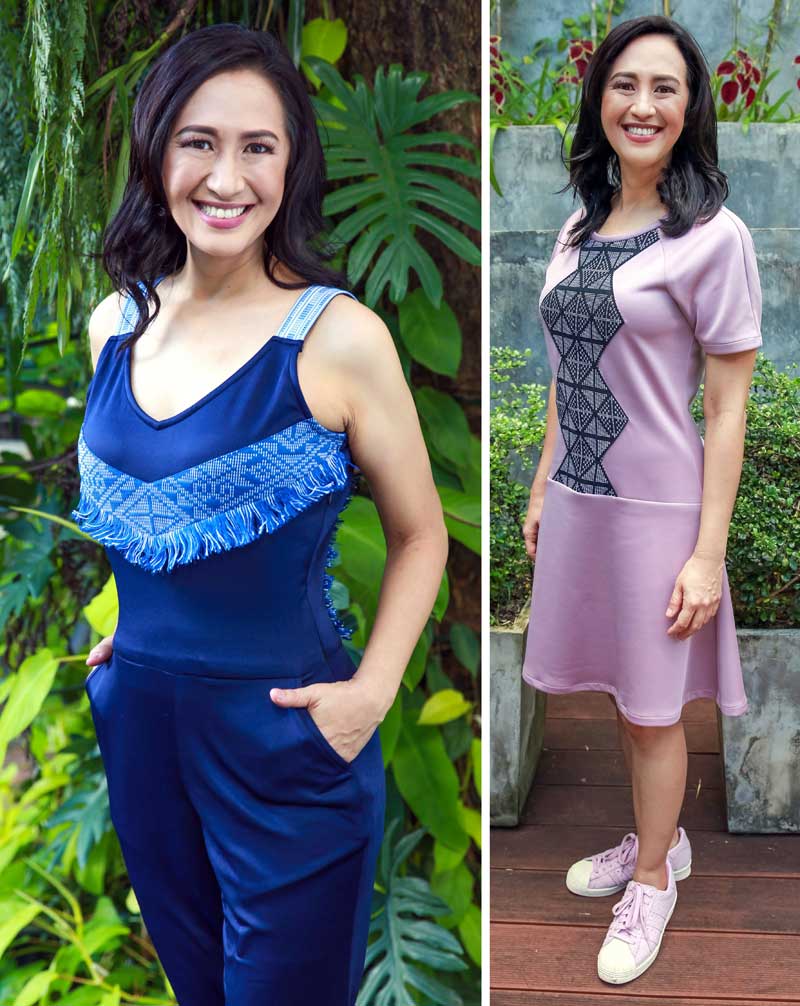
Kat jumpsuit (left photo) with two patterns of handloom Yakan weaves by Linea Etnika; handloom yakan weaves drop waist Betty dress(named after her mom Betty Go-Belmonte) in modern stretch fabric
Joy Belmonte
Joy Belmonte–Alimurung has served as Vice Mayor of Quezon City for three terms. Her pet projects include the Kabahagi Resource Center for Children with Disabilities which provides free services to kids suffering from various disabilities; and the Tindahan ni Ate Joy, a livelihood support project for single parents. A staunch advocate of Philippine-made products, she and her partner Looie Lobregat promote love for local through their Linea Etnika line.
My interest in Philippine-made clothes and accessories began when I first got elected to public office and was required by protocol to wear Filipiniana on numerous occasions during the year, such as the State of the City Address, the annual Quezon City Gabi ng Parangal and the many celebrations commemorating historical events or milestones in the lives of our national heroes.
The person that opened my eyes to the beauty of local products was my father, Congressman Feliciano Belmonte of the 4th District, who always gave me authentic tambourines and other locally crafted jewelry he would buy from antique dealers. Some would have been museum pieces had they been excavated scientifically rather than looted by treasure hunters and sold to collectors, thereby eradicating their provenance.
Growing up, I thought locally made wares and clothing were costume-like and worn only during Linggo ng Wika.
Now, my favorite RTW local brands are Amarie, Linea Etnika, Kaayo, Allegre, Christiana and Great Women. My favorite designer for Filipiniana gowns and barong blouses is Tippi Ocampo. For bags my choices are Beatriz, R2R and Louie Bayong. I also love buying Filipino-made textiles and designing my own outfits. People know me so well now that I get a lot of fabric from Mindanao for Christmas and my birthday, which I turn into office attire.
What I appreciate most about the local wares I use is that they are actually very comfortable and can be worn from the barangay, to office meetings, to conferences, all the way to evening functions. All I need to do is to change my shoes, pants or skirt to befit the occasion.
When I wear local, I feel really proud of my heritage, and as a role model for women and girls, I am happy that some of our barangay and SK officials have started copying my look and are now going local as daily staples, too.
My wish for local artisans, designers and weavers is that their products become globally recognized and appreciated to the extent that our country will not only be known around the world for our talented entertainers and filmmakers, but also for our quality craftsmanship, competitive designs and innovativeness in the field of fashion. However, I also wish that someone out there can democratize them more because at the moment, I feel that many of these products are very costly and only accessible to a select few.
I am happy though that with the influx of all these local artisanal brands, the well-to-do people I know who once only patronized European couture now also purchase local with pride.
My local must-haves when I go to work meetings or when I travel abroad for conferences are the Elena jackets of Linea Etnika, the short-sleeved pastel barong tops of Amarie Studio and the linen dresses of Kaayo. My signature outfit for everyday use is undoubtedly the Joy dress by Linea Etnika, which my dearest friend and business partner Looie Lobregat designed and named after me. I must have about a dozen of them.

Abra weave apron top (left photo) by Ivar Aseron, shorts by Filip+Inna; Binakol weave corset and tuxedo pants with binakol piping (right) by Joey Samson, necklace by Joyce Makitalo, earrings by Erica Concepcion-Reyes of Riqueza, gold cuff by Arnel Papa
Emmeline Villar
Emmeline Aglipay-Villar is a party-list Congresswoman who is also Undersecretary of the Department of Justice. This lawyer shares with her husband, Public Works Secretary Mark Villar, a passion for nation building. An advocacy close to her heart is the Hope for Lupus Foundation which she co-founded.
My interest in Philippine-made clothes and accessories began when I was in grade school and I came across a baul with some of my Lola’s ternos with impeccable calado embroidery on nipis fabrics.
The person that opened my eyes to the beauty of local products was my mother, who took me with her to her trips to backyard factories in Laguna when my father was assigned there in the early ’90s. This is where I saw the beautiful handmade shoes and bags made in Liliw, pandan bags made in Luisiana, and the finest embroidery in Lumban.
Growing up, I thought locally made wares were old-fashioned, or that clothes made of local weaves were only to be used for formal occasions.
Now, my favorite local designers are Inno Sotto, who is a master in the construction of the terno and a pillar in the development of Filipiniana; Ivar Aseron and Joey Samson who are both able to apply this unique design aesthetic to modernizing traditional Philippine attire; and Randy Ortiz, who makes the most beautiful and romantic embroidery, reminiscent of the 1800s but every bit as relevant and appropriate today.
What I appreciate most about our local wares is that they remind me constantly of how talented Filipinos are and how rich our country is in natural resources that make our local wares more interesting and uniquely Filipino.
When I wear local, I feel extremely proud. It is like wearing a badge of love for country and our people and wherever I am, I always feel that I am home.
My wish for the local fashion industry is to make our local weaves, Philippine methods of clothing construction and inspirations from traditional Filipino attire — like the traje de mestiza, saya, terno or balintawak — popular, widely used, and identified as Filipino all over the world.
My local must-haves when I travel are an abaca hat, Kaayo tankulo scarf and Ninabel Binakul coat. I also always bring my Riqueza and Joyce Makitalo jewelry that get noticed 100 percent of the time.
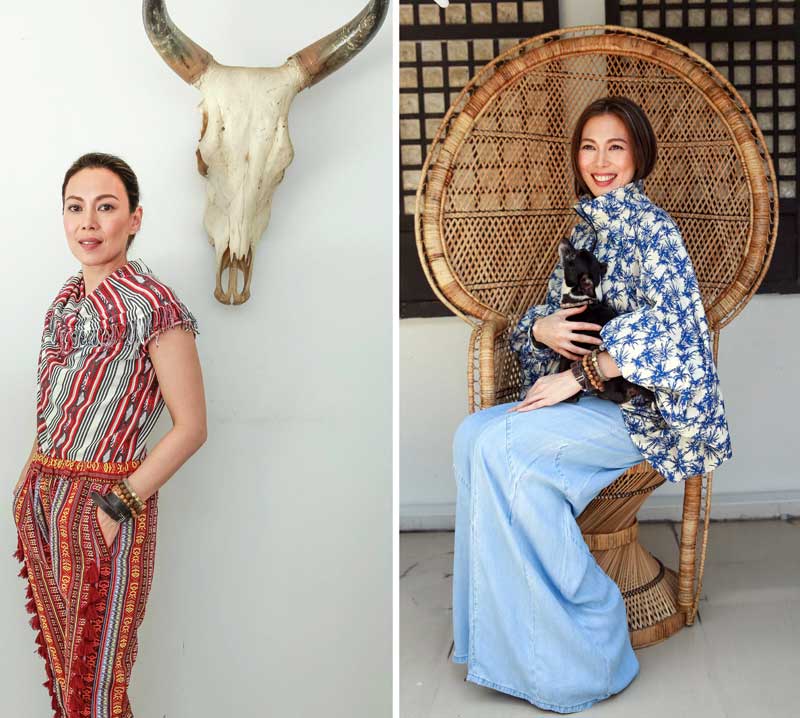
Woven pants (left photo) with tassels by Mandy de la Rama, paired off with a woven top from Junya Watanabe; printed puff-sleeved jacket (above) by Mandy de la Rama, wide-leg denim trousers from the SM Store
Mandy De la Rama
Mandy de la Rama, a favorite choice on perennial lists of best-dressed women, actually enjoys dressing up children through her Tarte Tatin line wahich she designs and manufactures through her Solene Garments company.
I have had my eponymous line for the last 15 years; however, when I was invited by Mons Romulo to participate in her quarterly popup called Katutubo, the caveat was that I’d have to come up with modern indigenous designs, which I did, and surprisingly was received warmly by her clients. So, in light of this, I now carry a mix of non-traditional and traditional clothing.
I can’t say that it was one person or event that led to my particular awareness of local products, as local fashion has always been around. Maybe it was just more singular then.
Growing up, I thought locally made wares were isolated to pasalubong pit stops strictly for the clueless foreigner.
Now, my favorite local designers? I have always been loyal to the holy triumvirate of Inno Sotto, Pepito Albert and Rajo Laurel for my clothing; Danielle & Sachrijara’s hand-woven abaca textiles for the home by my best friend Marivic Tambunting. The SM Store has a very curated selection of women’s wear that is stylish, well-made, affordable and extremely wearable.
What I appreciate most about our local wares is how far we’ve come. “Filipino” is now synonymous with style globally.
My wish for the local fashion weavers is funding for the workers who are short on education but big on skill; bigger looms so the width of the handmade fabrics are not limited to the current widths of 23-25 inches, which makes designing difficult and again, limiting.
My local must-haves when I travel? I am extremely tabang lamig, so I am never without my surprisingly warm silk/cotton wrap purchased from Mike Claparols.
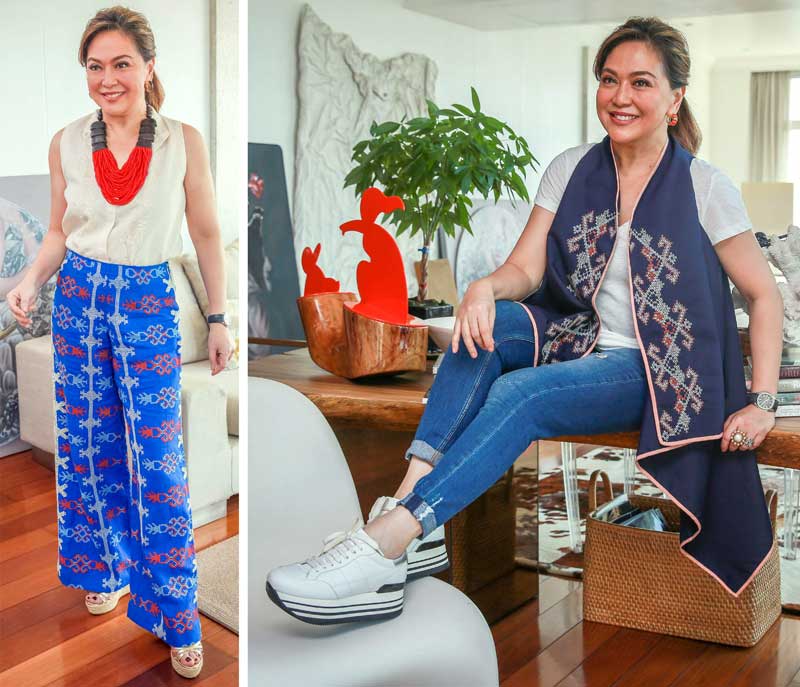
Petra pants (left photo) by Filip+Inna, barong top from Alegre by Techie Hagedorn ; vest (right) by Kaayo x Wilson Limon, rings by Hiyas, coral earrings by Kathy and Kathyt Bespoke
Karen Davila
Always proudly wearing Pinoy fashion on her TV shows, Karen Davila is a multi-awarded broadcast journalist who has both style and substance. Her documentary on children in jail got the UNICEF Child Rights Award, while her story on the danger from the Mindanao Mine Spill won a CNN World Report bronze Award. Her docu on children and drugs was awarded a silver medal by the New York TV & Film Festival.
My interest in Philippine-made clothes and accessories began when I started wearing Alegre jerseys, Filip+Inna T’boli weave and AmarieByAnne linen and jean barong dresses on my daily programs Headstart and Bandila.
The person/event that opened my eyes to the beauty of local products was Senator Loren Legarda. I remember seeing her wear beautiful tribal weaves on her TV show quite often, made then not by designers, but by the women from the communities themselves.
Growing up, I thought locally made wares were old and unwearable in daily city life. Absolutely untrue today!
Now, my favorites are Filip+Inna’s beaded pants, shorts and jackets;
Alegre’s jusi colored hombre barongs; AmarieByAnne’s linen barong embroidered caftans, resort wear tops and shorts, linen and jean barong dresses; Kaayo’s Tangkulo scarves, weaved sleeveless cape jackets and polos; Betina’s T-shirts and beaded jackets and now, Rhett Eala’s bomber jackets; PioPio’s bathrobes and throw-overs; Joyce Makitalo necklaces — I wear mine every day; Kathy and Kathy Bespoke, uniquely handmade looks that mirror Philippine history.
What I appreciate most about our local wares is that it’s about social entrepreneurship, which is wealth-inclusive. It’s time that we spent money knowing more of it goes to local artisans and community.
When I wear local, I feel proud to be Filipino
My wish for the local fashion industryartisans/weavers is to go global.
My signature outfit now is anything local. I love wearing barongs, T’boli tops to work.
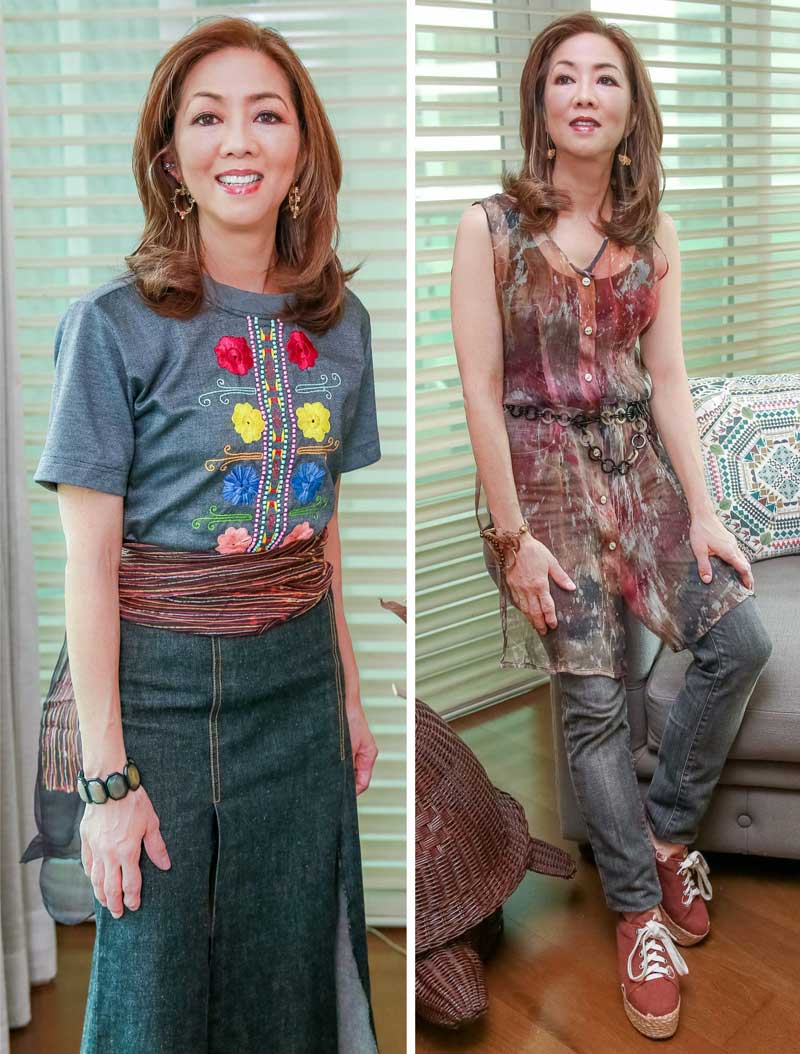
Embroidered blouse (left photo) by Jor-el Espina, vintage denim skirt by Rhett Eala, tepina scarf worn as a belt by Rurungan sa Tubod, earrings by Sanxi, bracelet by Silnag; sheer printed tunic (right) by Sisa x L’Herminia, earrings by Judy Jewelry, cuff by Eccentrics Limited, belt by Silnag
Cedie Lopez-Vargas
Cedie Lopez-Vargas is a passionate Philippine art and culture patron. She is a prime mover of ArteFino, a group dedicated to the promotion of Philippine-made products. She is executive director of the Lopez Memorial Museum and Library, head of logistics of ABS-CBN Corporation and a trustee of the Lopez Group Foundation.
My interest in Philippine-made clothes and accessories began when I was in my early teens. I would spend a lot of time examining handmade crafts looking for exceptional pieces that were out of the ordinary and wondering how they could get to the level of their global counterparts.
I enjoyed reading news articles and stories about locally made products that were enthusiastically patronized, both here and abroad.
I have a particular obsession with woven baskets.
The person that opened my eyes to the beauty of local products was Patis Tesoro. I spent many hours listening with absolute fascination as she spun stories of her adventures chasing after certain piña weavers, embroiderers and master craftsmen.
Growing up, I thought locally made wares could someday compete on global levels given the right amount of sustained focus and attention all throughout, from process to market.
What I appreciate most about our local wares is that aside from the sense of pride and appreciation of finely crafted products,
patronizing them regularly is a contribution towards fueling the local economy.
When I wear local, I feel that I am sustaining the threads and weaves of my culture and being an instrumental witness to the artisans and their stories.
My wish for the local artisans weavers is that they celebrate who they are and what they do, and never tire of seeking inspiration from that which is intrinsic to us as a people; and that they continue to find articulation and expression through their craftsmanship.
My local must-haves when I work and travel are silk shawls from La Union and Negros, barong-inspired denim shifts, indigenously inspired T-shirts and/or jackets,
denim tote bags by Touch of Craft, HaloHalo beach tote, embroidered or beaded cross-body bags, espadrilles by Luis Espiritu,
My signature accessory now? My Sanxi ear cuffs.
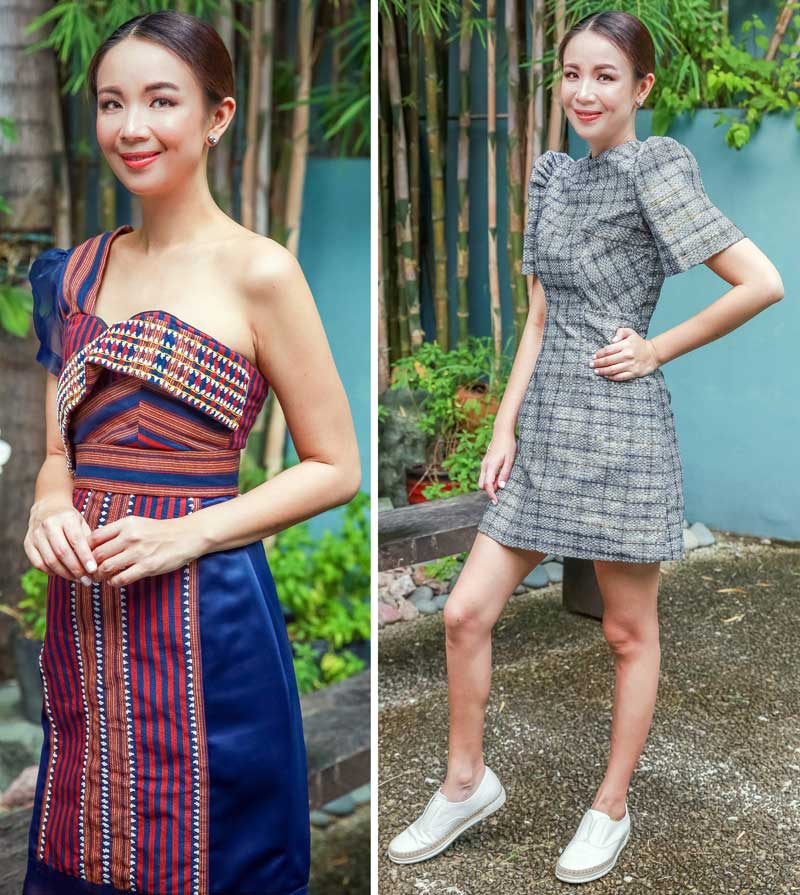
Asymmetrical woven dress (left photo) using Cordillera weaves by Narda’s x Sassa Jimenez; Estefania terno dress (right) by Anthill
Tootsy Angara
Tootsy Echauz Angara has been ABS- CBN‘s cluster head for sales for Channel 2 entertainment and lifestyle ecosystems for the past 23 years. As wife of Senator Sonny Angara, she does her share in public service by helping the children’s ward of PGH. Her advocacies include mental health awareness.
My interest in Philippine-made clothes and accessories began when I saw the precious photos of my mom (Baboo Mondoñedo) when she modeled for Pitoy.
The person that opened my eyes to the beauty of local products was my mom.She introduced me to Narda’s and other ethnic fabrics from the north and was thrilled when I wore it to the SONA.
Growing up, I thought locally made wares were super-cool! I wore local woven backpacks to school.
My favorite local designers? I love the way Rajo Laurel modernizes and plays with the local fabric we discover; Kathy and Kathy from Iloilo — their gorgeous designs created by local goldsmiths represent the heritage and worth of the Filipino family.
What I appreciate most about our local wares is that they're ours and we are helping a community.
When I wear local, I feel proud and inspired.
My wish for the local fashion industry is that we can multiply the demand by creating products for everyday use at a reasonable price.
My signature accessory now are my Zarah Juan sling-backs.
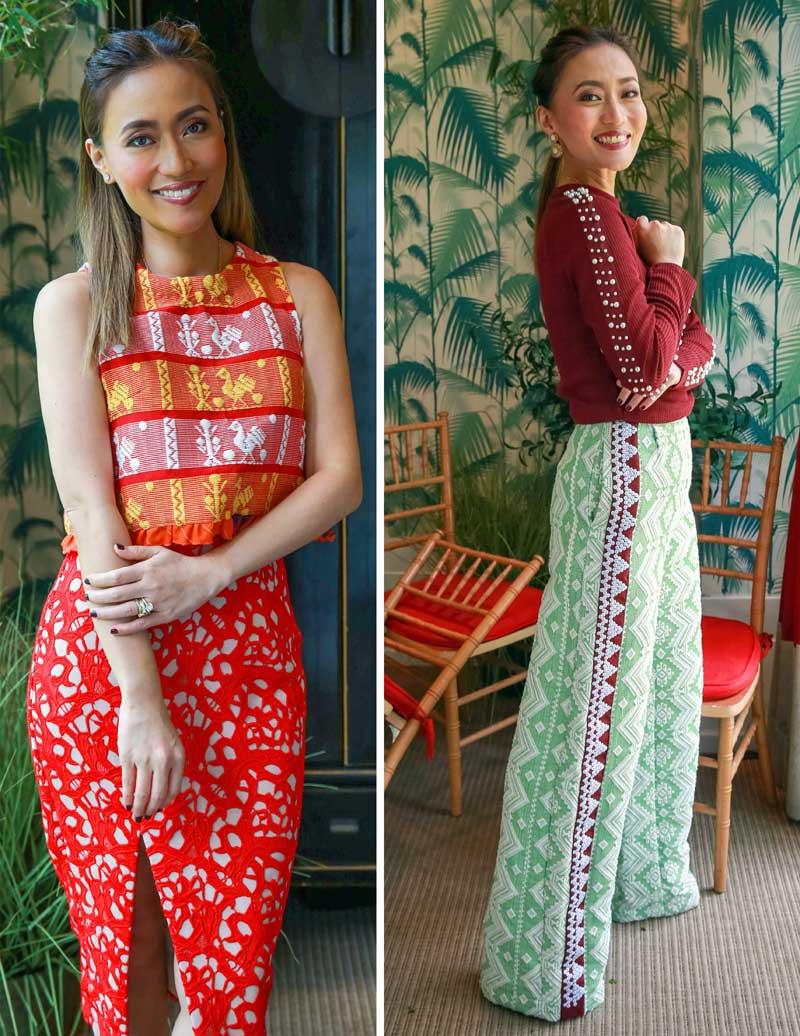
Marga cropped top by Kaayo Modern Mindanao (left photo), red lace dress underneath by Sheike; Inabel weave handbeaded by the T’boli; Stella pants by Kaayo Modern Mindanao (right), earrings and ring by Celia Mulano
Marga Nograles
Marga Nograles is a passionate advocate of Mindanao fashion, having long worked with her mother, Mary Ann Montemayor, under the Kaayo label they founded, to give livelihood projects to local weavers. As wife of Davao Congressman Karlo Nograles, Marga is also busy with projects created for the welfare of their constituents.
My interest in Philippine-made clothes began when my mom, Mary Ann Montemayor, lent me her vintage Mandaya jacket for an official trip I had to take with my husband eight years ago. Everywhere I went, people asked me where I got my jacket. From then on, I would raid my mom’s closet every chance that I got. My mom has a beautiful collection of jackets and scarves made by the Mindanao indigenous tribes because she has been working with them, helping them for over two decades.
My mom's love and passion for all things local is incomparable. She would do anything for her Mindanao. And, of course, because I am her only child, that love naturally became mine, too. I remember she would always proudly wear Mindanao, long before anyone cared for it. She would tell me that as a tourism practitioner 20 years ago, tourists hesitated to come to Davao due to peace-and-order concerns, so because of this, she made it a point to bring Mindanao to the world as often as she could by wearing ethnic jackets, scarves and shawls to travel and trade shows. She, along with her team, presented the beauty of our region and encouraged the world to visit.
Growing up, I thought locally made wares were too close to home. I kept seeing jackets, weaves and ethnic prints. At that time I didn’t care for it. After studying in Manila then eventually working in New York, then back to Manila again, I realized the value of the treasures from my hometown. Then slowly I dreamed of how we could bring and repackage Mindanao for the rest of the Philippines, then eventually abroad.
Now my favorite artisans are the Bagobo Tagabawa tribe of Davao and the T’boli Tribe of Lake Sebu. They are both colorful indigenous tribes that give all their heart to their craft. In a day and age where everything is fast-forward, these women spend hours, weeks and months weaving, beading and doing embroidery. Every step they try to make perfect; therefore, the products they come up with are truly outstanding. But more than their talent and hard work, these tribes are also very excited, so eager to learn, to explore and always so very thankful and grateful. It is a joy to be with them and I am so honored to be working with them.
What I appreciate most about our local wares is that they carry so many stories — of our history, our culture, and a simple story of the Filipino who made the piece. Most of the women I talk to tell me that their beading patterns and weaves come to them in their dreams. How beautiful to be wearing someone’s dream.
When I wear local, I feel I make these artisans’ dreams come to life, and I feel that I am doing a little something for my country, no matter how small.
My wish for the local fashion industry is for us to continue to be inspired. Never stop learning, never stop evolving, never stop weaving and never stop dreaming. I dream also that we, as Filipinos, continue to promote local and support what is ours.
My local must-have when I travel is still forever my Kaayo Bagobo Tangkulo scarf, T’boli sweater and Bagobo or T’boli jacket. These three come with me everywhere I go. My sweater is my savior in the airplane when the temperature suddenly drops. When I wear any of these three — no fail — people come up to me and ask me where I got them. It makes me so kilig and so very proud to be Filipino.
* * *
Follow the author on Instagram and Facebook@milletmartinezmananquil. Email her at mmmananquil@philstarmedia.com.



















